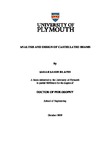ANALYSIS AND DESIGN OF CASTELLATED BEAMS
| dc.contributor.supervisor | Li, Long-yuan | |
| dc.contributor.author | Elaiwi, Sahar Sahib | |
| dc.contributor.other | School of Engineering, Computing and Mathematics | en_US |
| dc.date.accessioned | 2019-10-25T10:11:23Z | |
| dc.date.available | 2019-10-25T10:11:23Z | |
| dc.date.issued | 2019 | |
| dc.date.issued | 2019 | |
| dc.identifier | 10464537 | en_US |
| dc.identifier.uri | http://hdl.handle.net/10026.1/15061 | |
| dc.description.abstract |
The castellated beam is one of the steel members which uses less material, but has equal performance as the I-beam of the same size. Most of the castellated beams are fabricated from a standard universal I-beam or H-column, by cutting the web on a half hexagonal line down the centre of the beam, then these two halves are moved directly across by a half unit of spacing and re-joined by welding. This process leads to increasing the beam’s depth and thus the bending strength and stiffness about the major axis, without adding additional materials. This allows castellated beams to be used in long-span applications with light or moderate loading conditions for supporting floors and roofs. In addition, the fabrication process creates openings on the web, which can be used to accommodate services. Existing studies have shown that the resistance of the castellated beam is influenced by shear stresses, particularly those around web openings and under the T-section, which could cause the beam to have different failure modes. Therefore, web openings may reduce the shear resistance of the castellated beam. However, previous studies confirm that the method of analysis and design for the solid beam, may not be suitable for the castellated beam. Design guidance on the strength and stiffness for castellated beams is available in most countries, but also, some of them do not take into account the shear effect because as far as the bending strength is concerned, neglecting the shear effect may not cause direct problems. However, for the buckling and calculation of serviceability, the shear weakness due to web openings in castellated beams, could affect the performance of the beams and thus needs to be carefully reconsidered. The aims of this study are, firstly to investigate the effect of web openings on the transverse deflection and lateral-torsional buckling of castellated beams, by using both analytical and numerical methods, whilst also adopting some of the previous studies for validating the analytical results. The second aim, is to focus on the effect of both the geometric nonlinear and material inelasticity on castellated beams, under uniformly distributed load within different boundary conditions, through investigating the load-deflection curve and predicting the value of lateral-torsional buckling moment capacity, by using nonlinear numerical analysis method. The third aim, is to study the free vibration, static buckling and dynamic instability of castellated beams, w subjected to transverse periodic loading by developing analytical solutions. The purpose of developing analytical solutions, which adopt the classical principle of minimum potential energy, is for the design and practical use; while the numerical solutions developed using the commercial software ANSYS are for the validation of the analytical solutions. By examining the results of analytical and numerical solutions obtained, a number of important features of the castellated beams are identified. This study has contributed to enhancing the knowledge of the effect of web openings on the performance of castellated beams subjected to uniformly distributed transverse loads with/or without being exposed to elevated temperatures. Data provided in these studies, can essentially be used by structural designers for providing better, economical and safe structures. | en_US |
| dc.description.sponsorship | Ministry of Higher Education and Scientific Research (MoHESR) | en_US |
| dc.description.sponsorship | Ministry of Higher Education and Scientific Research of Republic of Iraq | en_US |
| dc.language.iso | en | |
| dc.publisher | University of Plymouth | |
| dc.subject | Transvers Deflection | |
| dc.subject | Lateral Torsional Buckling | |
| dc.subject | Dynamic Analysis | |
| dc.subject | Finite Element | |
| dc.subject | Linear and Nonlinear | |
| dc.subject | Energy Method | |
| dc.subject | Loads, uniformly distributed | |
| dc.subject | Temperature, non-uniform | |
| dc.subject | Pinned-fixed Supported | |
| dc.subject | Simply Supported | |
| dc.subject | Castellated Beam | en_US |
| dc.subject | Shear Effect | en_US |
| dc.subject.classification | PhD | en_US |
| dc.title | ANALYSIS AND DESIGN OF CASTELLATED BEAMS | en_US |
| dc.type | Thesis | |
| plymouth.version | publishable | en_US |
| dc.identifier.doi | http://dx.doi.org/10.24382/925 | |
| dc.rights.embargoperiod | No embargo | en_US |
| dc.type.qualification | Doctorate | en_US |
| rioxxterms.version | NA |
Files in this item
This item appears in the following Collection(s)
-
01 Research Theses Main Collection
Research Theses Main


